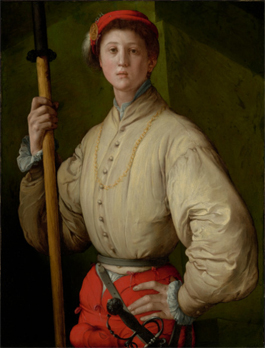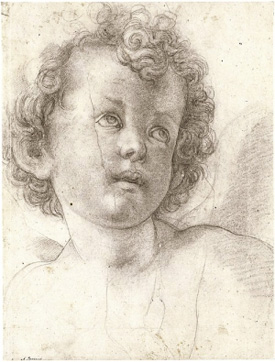Renaissance Capital
John Haberin New York City
The Medici: Portraits and Politics
The Met has a story to tell, about the greatness of the Italian Renaissance. For those, like me, who love the Renaissance and dream of a return to Florence, it will be a familiar one.
It is about how a banking family, the Medici, took control of the Florentine republic. It is about how the family's patronage empowered Italy's most progressive artists and transformed the city into a cultural capital. But wait: this is not the story you have heard, these are not the artists you thought you knew, and it is only barely the Renaissance. "The Medici: Portraits and Politics" begins nearly a hundred years later, in 1512,  and sees a turning point in the assassination of Alessandro de' Medici in 1537 and the ascent of Cosimo I to duke of Florence and grand duke of Tuscany. It is utterly insane as history or art, but it provides a rare and precious survey of Agnolo Bronzino and the late Renaissance portrait.
and sees a turning point in the assassination of Alessandro de' Medici in 1537 and the ascent of Cosimo I to duke of Florence and grand duke of Tuscany. It is utterly insane as history or art, but it provides a rare and precious survey of Agnolo Bronzino and the late Renaissance portrait.
It includes Cosimo's wife and child, posed for Bronzino, hardly caring if they upstage the duke himself. And why not, for she brought him an alliance with royalty? It includes a portrait by Jacopo da Pontormo with bushy hair and a pink top that have taken on lives of their own. It includes two friends, again by Pontormo, at ease in each other's company—unless, that is one asks just whose attention they are seeking offstage. Clearly something has become unsettled, even as the Renaissance has all but ground to an end. But is its subject portraiture, politics, or the Medici?
Tombs and ghostly arches
You may know the family from the Medici chapel in Florence, in the church of San Lorenzo. Michelangelo designed its pristine but sumptuous interior starting in 1519. His carvings of dawn and day are more moody and moving than even dusk and night. Lorenzo de' Medici, who died in 1492, looks down on his tomb, hand on his chin and finger to his mouth, in contemplation of far more than death. Facing him is his older brother, Giuliano, known in his lifetime as a golden boy and posed here as a calm but immovable warrior. They would fit right in with Michelangelo's painted prophets and nudes for the Sistine Chapel.
You may know them, too, from the Medici sculpture garden, which taught so many their art. Sculpture and architecture often preceded painting back then—going back to Filippo Brunelleschi, who designed the basilica of San Lorenzo in the 1420s and its older sacristy, which Michelangelo outdid. He lost the competition for the doors to the Baptistry to Lorenzo Ghiberti, who could be said to have launched the Renaissance in the process. But then Donatello was freeing sculpture physically and emotionally, and painters like Fra Angelico took note. Cosimo de' Medici the Elder was not the first in the family to throw his weight and his wealth around, but he patronized Donatello and Fra Angelico alike. As a banker, he knew all about cultural capital, in hard cash.
Then again, you may know them all from a single painting by Sandro Botticelli—his Adoration of the Magi from the early 1480s. Could that be Cosimo the Elder as foremost of the three kings, close enough to the holy family to touch? It is certainly Lorenzo standing at left, gesturing toward them as if presiding over the miracle. A brother looks down rather than look on, barely able to overcome his awe or his native sadness. At the far right, face turned to the viewer, the young artist may be the weightiest and most sympathetic of all, but he is just one among many. This is a political and intellectual portrait of Florence.
It does not take place in a vacuum—or for that matter, in the space of the long, lonesome journey of the magi to Bethlehem. They and a dozen others, not counting their horses, fill the ruins of a majestic stone shelter, in Botticelli's flawless perspective. Ghostly Roman arches recede at left, but never mind them: this, like Renaissance Florence, is the place to be. The kings, for once, do not come bearing gifts. They and their train alone are enough.
Every last bit of this story is notable at the Met—but by its absence, in favor of a more dubious history. Were the Medici just coming to power in the 1500s? Evidently not, although they threw off the trappings of the republic to become aristocrats and popes, and their banking interests were now in the service of popes as well. Not everyone went along, the Met concedes, and the turmoil led to outright rebellion and the siege of Florence by the Holy Roman Empire in 1527. Both failed, but by then the cultural capital had already shifted, away from Florence, as Michelangelo and Raphael, to name just two, headed for Rome. The first complained that his donor back home, Giulio de' Medici, was not following through on his promises.
By 1537, the Renaissance and the Renaissance collector themselves were all but past, right down to the poetry and madness of Mannerism. The Met has already surveyed the Renaissance portrait, in 2012 (and later "Hidden Portraits"), but that was from the 1400s. The artists here may take up the last eight or ten pages of an enormous Renaissance history text, along with additional portraits by Hans Holbein, mostly to lament them. Is this, then, just a museum's begging for attention and a scholar's career move? The Met specializes in both, as in its recasting of the Northern Renaissance and its reattribution of the Mérode Altarpiece in the Cloisters. It seems hardly to care for duly informing the public, and it never once admits to doubts.
Feel the chill
Perhaps it should just have claimed a little less in support of a fine show—or something else again. As a survey of Agnolo Bronzino, court painter to Cosimo I, it is without precedent, with nearly thirty works in oil plus sketches in black chalk. As a show of late Renaissance portraits, it is unique as well. It has a portrait of Lorenzo by Raphael, in a costume so elaborate that one can only wonder how far he had traveled from High Renaissance restraint, despite an early death. It has a man in black by Titian in Venice, with a sobriety, volume, and nuance that puts Florence to shame. It concludes with Bronzino and his lesser-known rival, Francesco Salviati, with insight into what distinguishes them both.
Just as valuable, it has eight paintings and studies in red chalk by Bronzino's teacher, Jacopo da Pontormo, who looks downright mainstream by comparison. Like Rosso Fiorentino (with a single work in the show), Pontormo was of Mannerism's provocative and tormented first generation. In his religious paintings, people slip in and out of the High Renaissance pyramid, bringing it to the point of collapse, their anxiety vivid in their faces.  In portraits, it turns out, his command of volumes is more evident and its undercurrents more subtle. The face of a soldier, a halberdier, might be on acid, but the artist seems more and more grounded and sane. If you ever wondered what makes the weapon in the soldier's hands a halberd, the Met also has samples, along with medals and other decorative arts.
In portraits, it turns out, his command of volumes is more evident and its undercurrents more subtle. The face of a soldier, a halberdier, might be on acid, but the artist seems more and more grounded and sane. If you ever wondered what makes the weapon in the soldier's hands a halberd, the Met also has samples, along with medals and other decorative arts.
Last but not least, it does indeed enter the sixteenth-century culture wars. The curators, Keith Christiansen with Carlo Falciani of the Accademia di Belle Arti in Florence, argue that the Medici ruled by soft power, and that meant the power of poetry and art. Bronzino himself turned out verses, on view in his own hand, and dignified a woman poet by painting her less than attractive profile. The show's one recurring motif is a book, title unseen, as testimony to a dignified aristocrat and a restive mind. Quite a few subjects mark their place in their reading with their fingers, but then Bronzino makes the most of gestures. When a mother poses with her child, they stand almost apart, even as their hands weave together.
The show's devotion to portraits has its limits, if only the limits of its reputed theme. Many sitters have nothing much to do with the Medici, although it opens with busts of Cosimo I that would make up for a lot. Benvenuto Cellini translates the twists and turns of hair and features into decoration and drama. In turn, the show cannot include Cellini's bronze fountain for Cosimo, because it cannot be moved, but also because it is not a portrait. It cannot include Bronzino's The Exposure of Folly, painted for Cosimo, with Cupid fondling Venus as another cupid smirks, Truth looks on in horror, and Father Time eggs them on. If the title demands a moralist, this artist prefers a more titillating kind of exposure.
He also created portraits as allegories, for more of power and poetry. When Cosimo poses as Orpheus, with a lyre and (I have to think) his real-life dog in the role of Cerberus, who guarded the gates to Hades, he anticipates the sensual charge of John with a ram for Caravaggio in the next century. The Met notes the evident homoeroticism, but the painter of Venus and Cupid was an equal opportunity lecher. And that again raises the question of what sets Bronzino apart, even as his subjects blend together. He adopts and even enhances his teacher's volumes, but with surfaces as brittle and smooth as porcelain. He has the tense gestures, with a polish that is unnerving as well.
Salviati, in contrast, prefers shallow spaces that press in from the picture plane. He also leans to awkward props, shining armor, and naturalistic features. Faces for Bronzino are only masks—but the masks that they chose to project. He can seem to pursue realism or an ideal of beauty, welcome or disdain, because his aristocratic sitters deny the difference. They want to believe that their hard and soft power will last forever. Viewers ever since have felt the chill.

"The Medici: Portraits and Politics" ran at The Metropolitan Museum of Art through October 11, 2021.




